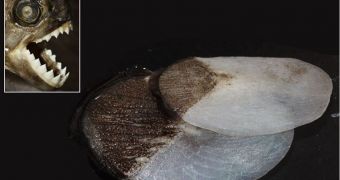Piranhas are known to be extremely aggressive fish, which attack and swarm everything from smaller fish to humans. They live inside rivers and lakes in the Amazon, and have a very high kill rate. In fact, they can overcome any fish but the arapaima.
This is one of the largest species of freshwater fish in the world, and also a living fossil. It first developed in the Miocene Epoch, which lasted from 23 to 5.3 million years ago. During these eons, it managed to become perfectly adapted to its environment.
One of these adaptations includes the development of a very special type of scales, which literally make the fish impervious to piranha attacks, even if the predators come at it in very large numbers.
This is why the arapaima is one of the very few species capable of swimming and going about their daily business in piranha-infested lakes and rivers. The new study was conducted by researchers at the University of California in San Diego (UCSD).
Mechanical engineer Marc Meyers, a co-author of the study, was one of the co-leaders for the new investigation. He once captured a member of the Arapaima gigas with a fishing line. These fish can grow to be about 2.5 meters (8.2 feet) long, and weigh 200 kilograms (441 pounds).
One of the most interesting aspects of these fish is that they still have residual lungs, which means that they need to breathe air. Another interesting aspect is the fact that it has silver-and-black scales that are up to 10 centimeters (4 inch) in length.
In a paper published in the latest online issue of the journal Advanced Engineering Materials, researchers describe an experiment in which they attached a piranha fang onto a machine that delivered powerful thrusts to an arapaima scale.
The team found that the tooth not only ricocheted off the scale, but was actually shattered on impact. When a scanning electron microscope was used to investigate the scales close-up, the experts found that they were made up of two layers.
The inside one was made up of sheets of collagen, a material that is very tough, but also elastic. The layer on top was as solid as a rock, made up of collagen cemented together with calcium. This is the mineral that gives bones their strength.
This type of armor is also present in our teeth, which are covered in tough enamel, but have an inner layer made of more elastic dentine, Science Now reports.

 14 DAY TRIAL //
14 DAY TRIAL //